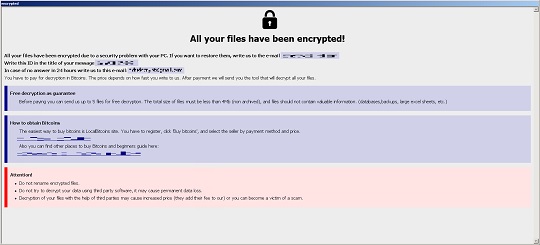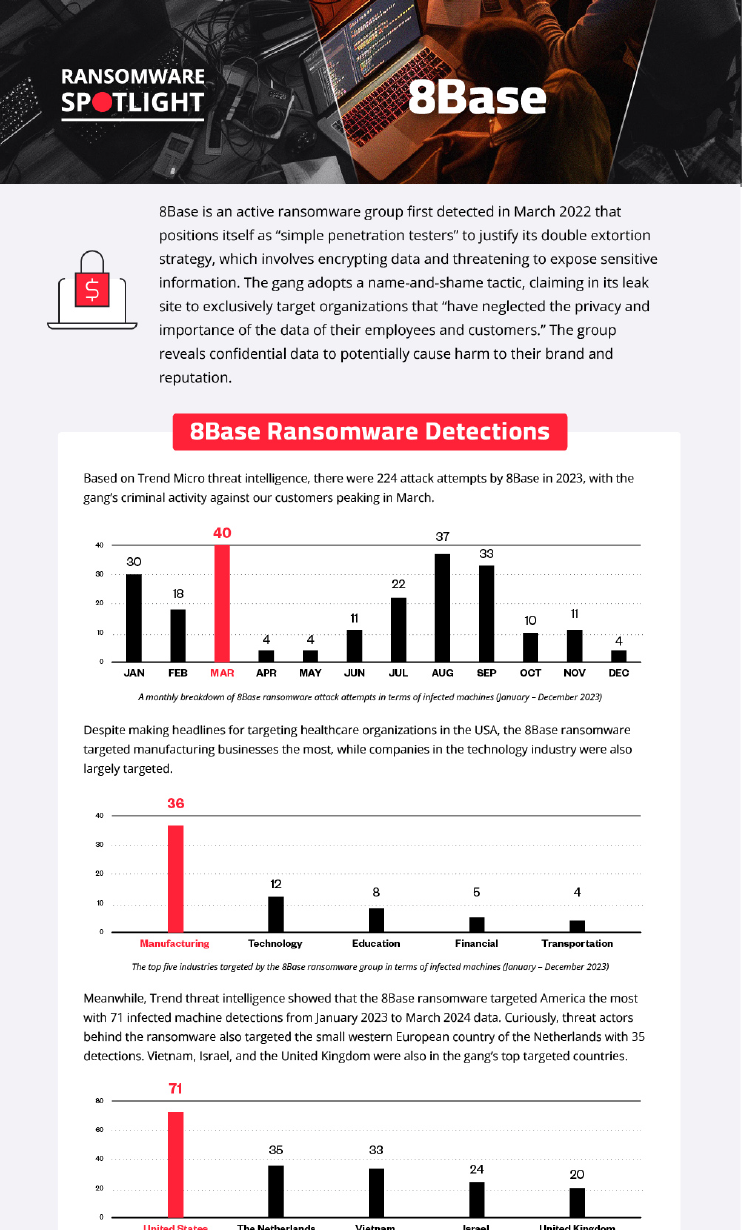Ransom.Win32.PHOBOS.SMYXCCW
Win32:Phobos-D [Ransom] (AVAST)
Windows


Threat Type: Ransomware
Destructiveness: No
Encrypted:
In the wild: Yes
OVERVIEW
This Ransomware arrives on a system as a file dropped by other malware or as a file downloaded unknowingly by users when visiting malicious sites.
It drops files as ransom note. It avoids encrypting files with the following file extensions.
TECHNICAL DETAILS
Arrival Details
This Ransomware arrives on a system as a file dropped by other malware or as a file downloaded unknowingly by users when visiting malicious sites.
Installation
This Ransomware drops the following copies of itself into the affected system:
- %AppDataLocal%\{Malware file name}.exe
(Note: %AppDataLocal% is the Local Application Data folder, which is usually C:\Documents and Settings\{user name}\Local Settings\Application Data on Windows 2000(32-bit), XP, and Server 2003(32-bit), or C:\Users\{user name}\AppData\Local on Windows Vista, 7, 8, 8.1, 2008(64-bit), 2012(64-bit) and 10(64-bit).)
It adds the following processes:
- "%System%\cmd.exe"
- vssadmin delete shadows /all /quiet
- netsh advfirewall set currentprofile state off
- netsh firewall set opmode mode=disable
- wmic shadowcopy delete
- bcdedit /set {default} bootstatuspolicy ignoreallfailures
- bcdedit /set {default} recoveryenabled no
- wbadmin delete catalog -quiet
- "%System%\mshta.exe" "%Desktop%\info.hta"
- "%System%\mshta.exe" "%Public%\desktop\info.hta"
- "%System%\mshta.exe" "{Drive Letter}\info.hta"
- {Malware Path}\{Malware Filename}.exe
(Note: %System% is the Windows system folder, where it usually is C:\Windows\System32 on all Windows operating system versions.. %Desktop% is the current user's desktop, which is usually C:\Documents and Settings\{User Name}\Desktop on Windows 2000(32-bit), XP, and Server 2003(32-bit), or C:\Users\{user name}\Desktop on Windows Vista, 7, 8, 8.1, 2008(64-bit), 2012(64-bit) and 10(64-bit).. %Public% is the folder that serves as a repository of files or folders common to all users, which is usually C:\Users\Public in Windows Vista, 7, and 8.)
It adds the following mutexes to ensure that only one of its copies runs at any one time:
- Global\<
>{Volume Serial number}00000000 - Global\<
>{Volume Serial number}00000001
Autostart Technique
This Ransomware modifies the following registry entries to ensure it automatic execution at every system startup:
HKEY_LOCAL_MACHINE\SOFTWARE\Microsoft\
Windows\CurrentVersion\Run
{Malware Filename} = %AppDataLocal%\{Malware Filename}.exe
HKEY_CURRENT_USER\Software\Microsoft\
Windows\CurrentVersion\Run
{Malware Filename} = %AppDataLocal%\{Malware Filename}.exe
It drops the following file(s) in the Windows User Startup folder to enable its automatic execution at every system startup:
- %User Startup%\{Malware Filename}.exe
(Note: %User Startup% is the current user's Startup folder, which is usually C:\Windows\Profiles\{user name}\Start Menu\Programs\Startup on Windows 98 and ME, C:\WINNT\Profiles\{user name}\Start Menu\Programs\Startup on Windows NT, C:\Documents and Settings\{User name}\Start Menu\Programs\Startup on Windows 2003(32-bit), XP and 2000(32-bit), or C:\Users\{user name}\AppData\Roaming\Microsoft\Windows\Start Menu\Programs\Startup on Windows Vista, 7, 8, 8.1, 2008(64-bit), 2012(64-bit), 10(64-bit).)
Process Termination
This Ransomware terminates the following processes if found running in the affected system's memory:
- msftesql.exe
- sqlagent.exe
- sqlbrowser.exe
- sqlservr.exe
- sqlwriter.exe
- oracle.exe
- ocssd.exe
- dbsnmp.exe
- synctime.exe
- agntsvc.exe
- mydesktopqos.exe
- isqlplussvc.exe
- xfssvccon.exe
- mydesktopservice.exe
- ocautoupds.exe
- agntsvc.exe
- agntsvc.exe
- agntsvc.exe
- encsvc.exe
- firefoxconfig.exe
- tbirdconfig.exe
- ocomm.exe
- mysqld.exe
- mysqld-nt.exe
- mysqld-opt.exe
- dbeng50.exe
- sqbcoreservice.exe
- excel.exe
- infopath.exe
- msaccess.exe
- mspub.exe
- onenote.exe
- outlook.exe
- powerpnt.exe
- steam.exe
- thebat.exe
- thebat64.exe
- thunderbird.exe
- visio.exe
- winword.exe
- wordpad.exe
Other Details
This Ransomware does the following:
- It scans specific database related file extensions:
- fdb
- sql
- 4dd
- 4dl
- abs
- abx
- accdb
- accdc
- accde
- adb
- adf
- ckp
- db
- db-journal
- db-shm
- db-wal
- db2
- db3
- dbc
- dbf
- dbs
- dbt
- dbv
- dcb
- dp1
- eco
- edb
- epim
- fcd
- gdb
- mdb
- mdf
- ldf
- myd
- ndf
- nwdb
- nyfs
- qlitedb
- sqlite3
- sqlite
- It creates an anonymous pipe.
- Checks if the malware is executed in the following folder:
- {Malware file path}\admen
Ransomware Routine
This Ransomware avoids encrypting files with the following strings in their file name:
- info.hta
- info.txt
- boot.ini
- bootfont
- bin
- ntldr
- ntdetect.com
- io.sys
- admen
- {Malware Filename}.exe
It avoids encrypting files found in the following folders:
- %Windows%
- %ProgramData%\Microsoft\Windows\Caches
(Note: %Windows% is the Windows folder, where it usually is C:\Windows on all Windows operating system versions.. %ProgramData% is a version of the Program Files folder where any user on a multi-user computer can make changes to programs. This contains application data for all users. This is usually C:\ProgramData on Windows Vista, 7, 8, 8.1, 2008(64-bit), 2012(64-bit) and 10(64-bit), or C:\Documents and Settings\All Users on Windows Server 2003(32-bit), 2000(32-bit) and XP.)
It appends the following extension to the file name of the encrypted files:
- id[{Volume Serial Number}].[{BLOCKED}rypt@gmail.com ].faust
It drops the following file(s) as ransom note:
- %Desktop%\info.hta
- %Public%\Desktop\info.hta
- {Drive Letter}\info.hta

It leaves text files that serve as ransom notes containing the following text:
- %Desktop%\info.txt
- %Public%\Desktop\info.txt
- {Drive Letter}\info.txt

It avoids encrypting files with the following file extensions:
- faust
- actin
- dike
- acton
- actor
- acuff
- file
- acuna
- fullz
- mmxxii
- kmrox
- 6y8dghklp
- shtorm
- nurri
- ghostff
- 6om6
- mnx
- backjohn
- own
- fs23
- 2qz3
- top
- blackrock
- chcrbo
- g-stars
- faust
- unknown
- steel
- worry
- win
- duck
- fopra
- unique
- acute
- adage
- make
- adair
- mlf
- magic
- adame
- banhu
- banjo
- banks
- banta
- barak
- caleb
- cales
- caley
- calix
- calle
- calum
- calvo
- deuce
- dever
- devil
- devoe
- devon
- devos
- dewar
- eight
- eject
- eking
- elbie
- elbow
- elder
- phobos
- help
- blend
- bqux
- com
- mamba
- karlos
- ddos
- phoenix
- plut
- karma
- bbc
- capital
- wallet
- lks
- tech
- s1g2n3a4l
- murk
- makop
- ebaka
- jook
- logan
- fiasko
- gucci
- decrypt
- ooh
- non
- grt
- lizard
- flscrypt
- sdk
- 2023
- vhdv
SOLUTION
Step 1
Trend Micro Predictive Machine Learning detects and blocks malware at the first sign of its existence, before it executes on your system. When enabled, your Trend Micro product detects this malware under the following machine learning name:
- TROJ.Win32.TRX.XXPE50FFF075
Step 2
Before doing any scans, Windows 7, Windows 8, Windows 8.1, and Windows 10 users must disable System Restore to allow full scanning of their computers.
Step 3
Note that not all files, folders, and registry keys and entries are installed on your computer during this malware's/spyware's/grayware's execution. This may be due to incomplete installation or other operating system conditions. If you do not find the same files/folders/registry information, please proceed to the next step.
Step 4
Restart in Safe Mode
Step 5
Delete this registry value
Important: Editing the Windows Registry incorrectly can lead to irreversible system malfunction. Please do this step only if you know how or you can ask assistance from your system administrator. Else, check this Microsoft article first before modifying your computer's registry.
- In HKEY_LOCAL_MACHINE\SOFTWARE\Microsoft\Windows\CurrentVersion\Run
- {Malware Filename} = %AppDataLocal%\{Malware Filename}.exe
- {Malware Filename} = %AppDataLocal%\{Malware Filename}.exe
- In HKEY_CURRENT_USER\Software\Microsoft\Windows\CurrentVersion\Run
- {Malware Filename} = %AppDataLocal%\{Malware Filename}.exe
- {Malware Filename} = %AppDataLocal%\{Malware Filename}.exe
Step 6
Search and delete this file
- %AppDataLocal%\{Malware file name}
- %User Startup%\{Malware file name}
- %Desktop%\info.hta
- %Public%\Desktop\info.hta
- {Drive Letter}\info.hta
- %Desktop%\info.txt
- %Public%\Desktop\info.txt
- {Drive Letter}\info.txt
Step 7
Restart in normal mode and scan your computer with your Trend Micro product for files detected as Ransom.Win32.PHOBOS.SMYXCCW. If the detected files have already been cleaned, deleted, or quarantined by your Trend Micro product, no further step is required. You may opt to simply delete the quarantined files. Please check this Knowledge Base page for more information.
Step 8
Restore encrypted files from backup.
Did this description help? Tell us how we did.


